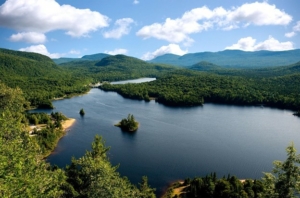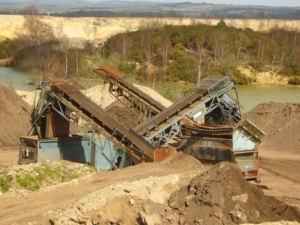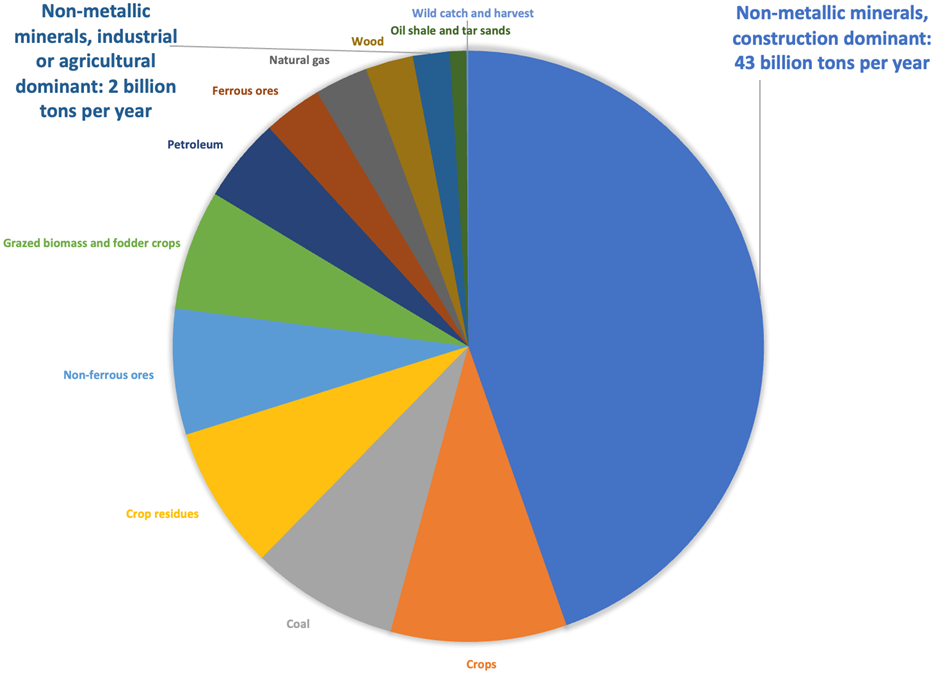Bulldozing the Planet
by Gregory M. Mikkelson
Just as it does for a certain “old man on a green bike,” my commitment to car-free travel often drives me to greater levels of exercise, and more vivid experiences of nature, than one would get behind the wheel of a car. Unfortunately, economic growth has progressively degraded one such experience. Trips to my partner’s lake cottage begin with a commuter train in Montréal and end with an hour-long walk on a dirt road through the countryside. But every time I make this hike, more of the woods have fallen to the chain saw, and more of the rock and sand has been gouged out from underneath.

No bulldozers—yet—in this corner of the Eastern Canadian Forest-Boreal Transition ecoregion (CCO 1.0, Werner Bayer)
Such mutilated landscapes are found across the world. Nearly half the material extracted from them goes to construction of buildings, roads, and other infrastructure, which in turn supports ever-expanding industrial economies. New construction initiatives threaten to compound the damage, from the U.S. Bipartisan Infrastructure Deal to China’s Belt and Road Initiative. As long as the global economy continues to grow, degradation and dysfunction will increasingly impair our planet’s natural systems.
Material Stocks and Flows
Obliteration of gorgeous, thriving forestland in Québec’s Laurentian Mountains typifies the extractive end of the ever-expanding flows of material that go along with exponential economic growth. One astounding result of all this mining and processing of raw materials was recently uncovered by scientists: Artifacts—mostly made of concrete, but with significant amounts of gravel, brick, asphalt, metal, and plastic as well—now outweigh the total mass of all living organisms on Earth. This finding grounds Herman Daly’s sage observation that “[w]e now live in a full world, full of us and our stuff.”

A land- and water-scape scarred by sand and gravel mining (Simon Scurr, CC-BY-SA 2.0)
In turn, the more stuff we have, the more additional raw material it takes to operate and maintain it all. Put differently, the greater the material stocks, the greater the material flows. This ever-greater overuse of raw materials is driving our fellow species extinct and degrading human life through air, water, land, noise, and light pollution.
Several years ago, other scientists introduced the concept of the “material footprint” to gauge whether any countries had really “decoupled” economic growth from growth in the use of raw materials. The material footprint tracks the tonnage of resources extracted, processed, transported, and eventually disposed of to supply the goods and services consumed in a given society in a given year. Like other footprint concepts, such as the ecological footprint, the material footprint can be used to hold societies accountable for environmentally destructive consumption, even if they have “outsourced” that destruction by importing goods and services from elsewhere. For this reason, we use material footprint data in the analysis below.
Types of Material Throughput
Material flows underlie all components of economic activity: goods, services, investment, government expenditures, among others. We could thus view material footprints as an alternative measure of GDP, expressed in tons rather than dollars. The pie chart shows the components of the world material footprint in 2019, when the world economy devoured a total of 96 billion tons of raw materials. Note that the largest wedge, “non-metallic minerals—construction dominant” accounted for the lion’s share of the materials used up that year, amounting to 45% of the total. These materials, along with the minerals used for industry and agriculture, make up the “non-metallic minerals” category—one of four main categories in the United Nations’ database on material footprints, along with “biomass,” “fossil fuels,” and “metal ores.”

The material footprint of the world economy as of 2019 (materialflows.net)
Thus, in terms of sheer mass—rather than other important criteria such as areal extent, toxicity, or impacts on human and non-human life—the construction industry dominates the world economy. Each week, that industry creates new structures greater in mass than the mass of the world’s eight billion people put together. Mainstream economists and governments are counting on new construction to wring still more economic growth out of the post-pandemic biosphere.
Extraction of minerals, including sand, gravel, and others that undergird the construction industry, disturbs 500,000 additional hectares of land each year (5,000 square kilometers, or 1,930 square miles). Such disturbances affect freshwater as well as terrestrial ecosystems. Indeed, extraction of sand and gravel from rivers and streams now poses a huge threat to freshwater biodiversity. Other construction materials cut or scraped out of the ground and/or riverbeds—mostly at ever-faster rates—include limestone, clay, dolomite, and gypsum. Partly because the structures built with these materials require additional inputs of raw materials for their operation and maintenance, their negative impacts on nature and society radiate far beyond their spatial boundaries. Waves of impact reach especially far from roads, which account for a large share of non-metallic minerals footprints.
GDP and Non-metallic Minerals Footprints
Global GDP and the non-metallic minerals footprint both skyrocketed from 1970 to 2019, to nearly five times their initial sizes, as the figure shows. Year-to-year changes in these two variables have a strongly positive and statistically significant correlation. Moreover, non-metallic minerals footprints also closely track national GDP. Averaged across 126 countries and over 50 years, non-metallic mineral throughput expands by six tons for every $10,000 of growth in GDP.
Among the world’s largest economies, China’s is in a class of its own. China now churns through more non-metallic minerals than any other country: 20 billion tons’ worth in 2019 alone. The country’s torrid GDP growth in recent decades translates to a greater increase in throughput of non-metallic minerals than in any other large economy: 37-fold over the past half-century.

Global GDP and its non-metallic minerals footprint, 1970-2019 (World Bank and UN)
None of the environmental variables covered in our forthcoming book GDP: The Untold Story—such as the fossil fuels footprint discussed in a previous Steady State Herald article—have “decoupled” from economic growth in an absolute sense. In other words, none of them have consistently improved in the face of continued economic growth—whether such improvement would mean an increase of something good, as in the case of biological diversity, or a decrease of something bad, as in toxic waste. But even worse, the non-metallic minerals footprint has not even decoupled from growth in a relative sense, meaning it has not declined per unit of GDP. At the global level, non-metallic mineral throughput has expanded faster than any other component of the material footprint, and proportionally just as fast as GDP.
What to Do?
The United Nations has designated material footprints an inverse measure of progress toward two Sustainable Development Goals (SDGs). The UN thus implicitly recognizes the need to reduce throughput of raw materials, of which construction materials make up the largest part. Sadly, though, the SDGs push even harder in the direction of increasing footprints. They do this by featuring economic growth, and construction of new infrastructure, in two of the 17 top-level goals. What can ordinary people do in the face of the growth/construction juggernaut?
It is perhaps best to start with one’s own life. By working, spending, investing, and of course reproducing less, individuals can help deflate demand for structures and the non-metallic minerals they contain. This also frees up time for recreation with kith and kin, in nature, and through hobbies. But crucially, it gives time to join with others in organizing resistance and alternatives to our current economic system.
In particular, we need a system that corrects the grossly unequal distribution of existing structures, rather than creating ever more of them. We can look to one-time housing-rights activist and now mayor of Barcelona, Ada Colau, for inspiration. Under her administration, buildings that sit empty for too long are appropriated by the city to help meet the need for affordable homes. Economic growth means ever more construction, which in turn means ever more environmental destruction. In contrast, a steady state economy would prioritize repair, restoration, and fuller and more equitable use of existing structures. This would allow for the protection and restoration of natural ecosystems.
Greg M. Mikkelson is CASSE’s ecological economist.










This article makes me think about how wrong I’ve been on many issues. Years ago in a small hot-weather city of Mexico, I asked a friend “why don’t you guys pave your streets?” “Paving would make our town even hotter,” he answered. Our city in France is engaged in a voracious building program. “All this cement cannot be good” I said to a local official, but he said they needed to increase density in order to improve mobility (the idea of a 5-minute city where everything is within walking distance), something we pedestrians and bicycle riders should support, right? With what Greg has written here, perhaps I should even question the pavement on our sacred bicycle lanes. Great article, with some frightening data.
Thanks for this comment Mark. I submit that enabling city dwellers to meet all their needs within walking distance naturally lends itself to a net reduction in pavement. Cars take up so much more space than other travel modes that shifting toward walking, biking, and public transport makes huge areas available for re-purposing as green space. I’ve mentioned before this kind of thing is happening here in Montreal, though not nearly as fast as it should.
Oof, this is sobering. I guess I’m glad that the UN has at least recognized material footprints as a negative metric of success. Let’s hope that is the beginning of more long term thinking and connecting the dots.
I’m struggling with the local implications here in Austin, Texas, of what I read, but the article creates a welcome struggling for my brain to have to ponder. Our city council majority and staffers want to significantly rezone the city, so as to pack more or at least higher buildings, especially residential, into the same ground-level square-footage. Ostensibly, this is to be done towards what they tout highly as a goal of affordable housing. But as far as I can tell, the idea is not: (a) more affordable housing for those who already live here, moving from and thus vacating their less affordable housing to leave it…what? (a)(1): Empty? (a)(2): Grassed over or trees planted? (I greatly doubt the grass or trees replacement scenario, given that they want to convert nearby green space–a modest golf course that’s been here since the 1890s, the perimeter of which is one of my nice hiking routes–to convert it to…affordable housing.) (a)(3): Available for conversion into commercial building structure, increasing that? Nor does the idea seem to be: (b) to create affordable housing for those who had to move to the suburbs, because gentrification the city enabled made it unaffordable to live here, to be able to return. That’s doubtful when their advocacy of affordable housing is said to be to accommodate the future city population growth they think to be inevitable and they welcome. So the exact nature of the resultant material footprint outcome is kind of hazy to me, if the city council majority and the affordable housing backers get their way, but I don’t see the outcome to portend any reduction of material footprint, wherever in Austin or elsewhere the associated structural material is obtained. And this is before we get to the issues that the human sardine packing, if traffic congestion trends are any clue, means more not fewer cars, and means more electricity demand the stress of which has twice now presented severe winter-freeze power outages in 2021 and 2023.
The sheer mass and growing momentum of this problem at a first glace looks unstoppable by mankind. Its important to remember that global economy growth is built on all of our individual decisions. Shall I drink a can of soda or plastic bottled water. Maybe I will drink a glass of tap water instead – better for the world and our futures. Success lies on harnessing our individual desires to behave responsibly, feeling included and safe within a like minded society. When society moves to embrace it, when we move beyond growth, sustainable solutions that stick can be created. In a steady state this might help..https://www.bbc.com/future/article/20230309-how-carbon-negative-concrete-can-help-the-climate there are other green cements and concrete being made with recycled rubble which can help. Greengrowthers the current mainstream, with its head in the sand greenly and unsustainably growing, shall see growth opportunities. We will likely see building codes improved, putting carbon and recycling targets at the planning stage. Well intended, but we need to change the all gobbling growth mindset.